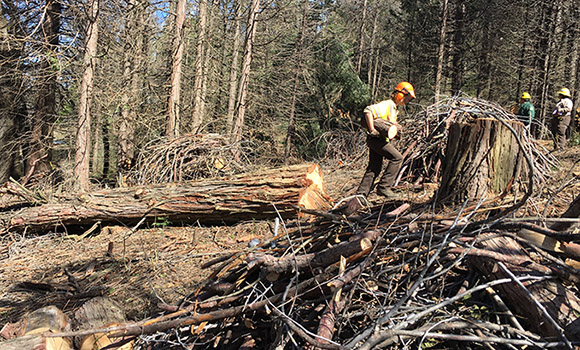
California Conservation Corps crew clears hazard trees (Photo: Raymundo Valencia/USDA)
Trees in California’s forests are dying at alarming rates, creating both problems and opportunities for rural communities and local economies with deep roots in the timber industry.
The California Natural Resources Agency in mid-October issued a set of recommendations on how to make better use of dead or dying trees, while promoting long-term forest health, carbon sequestration and rural economic development. The agency’s report is the latest in a growing effort to define and promote a new generation of forest-products that goes beyond traditional lumber to capture and emerging “biomass” industry.
The report, “Recommendations to Expand Wood Products Markets in California” outlines actions, policies and pilot programs to encourage the use of biomass. The report was released the same week Rural County Representatives of California (RCRC) and the University of California, Division of Agriculture and Natural Resources convened experts and interest groups to begin defining how biomass-related activities could advance the sustainability and prosperity of rural regions. Several participants in that session continued the conversation at the 2017 California Economic Summit, which took place last week in San Diego.
“There is a critical need to bolster our biomass processing capacity and expand uses for wood products not only to handle dead trees in the short term but also to assist with ongoing forest management and restoration,” California Secretary for Natural Resources John Laird said. “This can and should be done in a manner that advances California’s climate change goals and creates opportunities for rural communities.”
The report’s recommendations include:
- Remove Barriers to Market and Create Pathways for Success: To attract investors, state agencies can facilitate the permitting process, support product testing, align regulatory requirements and address financing challenges.
- Promote Innovation: Create an infrastructure that would bring new wood products from California to the market.
- Invest in Human Capital: Work closely with California’s public technical colleges and higher education systems to train the workforce needed to support the new industry.
Other states are turning to biomass to revive rural communities that have been hit hard by the downturn in the timber industry.
The country’s first high-rise building made of timber is set to start construction in Portland, Oregon. The 12-story Framework building will be built with cross-laminated timber, a new technology using large sheets of timber tightly pressed together. The state has invested in the project and the cross-laminated timber will be sourced in Oregon, even though most cross-laminated timber is produced in Europe and Canada.
The University of Idaho is planning a new basketball arena made out of wood. The proposed 4,700-seat Idaho Arena will not only house the university’s basketball and volleyball programs, it will also be used as an event center for conventions, concerts and community gatherings. The use of timber will highlight the state’s wood products industry in an effort to boost rural economies.
“The hope is to be able to compete with steel for the construction of large scale commercial buildings and facilities,” said Steven Peterson, assistant clinical professor at the University of Idaho’s College of Business and Economics. Peterson's report, “The Economic Impacts of the Idaho Arena on the Regional Economy,” outlines how the arena can bolster the state’s wood products industry as well as the economy in and around UI.
“Economies that exist in large cities can make change from one type of industry to another much easier. In rural areas, it’s much more difficult to make those transitions,” added Peterson. “So, take a look at your local strengths and build off of those and that’s what this does. It’s an emerging market we’ll be able to expand on it.” He expects the Idaho Arena will be a showpiece for new wood product technology and the Idaho’s timber industry.
The California Natural Resources Agency report shows the state is looking to biomass and new wood technology to help solve issues facing rural regions. The report was submitted to the State Legislature, which directed the agency via SB 859 to identify how the state could respond to California’s significant forest health issues.

